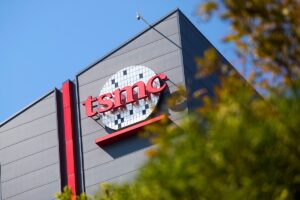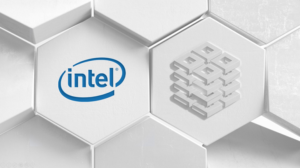The first one has its transformative generative AI solutions, the second one is expanding its global manufacturing footprint, and the third one’s relentless pursuit of cutting-edge process nodes signifies a watershed moment in tech.
This article delves into these behemoths’ strategic blueprints and technological edges, extracting insights into their growth trajectories. From the first pivot towards subscription-based models and AI dominance to the second one’s global expansion strategies and the third one’s revolutionary advancements in semiconductor manufacturing, each move shapes its fortunes and the industry landscape.
Broadcom (AVGO)

To begin with, in fiscal 2024, Broadcom (NASDAQ:AVGO) anticipates its semiconductor solutions revenue to grow by a mid- to high-single-digit percentage year-on-year (YoY). Financially, generative AI revenue, driven by Ethernet solutions and custom AI accelerators, demonstrated a growing significance for the company’s value growth. That already represents 15% of semiconductor revenue in fiscal 2023. Revenue from generative AI is expected to surpass 25% of semiconductor revenue, offsetting any lack of growth from non-AI semiconductor revenue.
Additionally, the networking segment within semiconductors, specifically Q4 2023 networking revenue, increased by 23% YoY, representing 42% of semiconductor revenue. The growth was primarily driven by solid demand from hyper scalers for AI accelerators, networking switches, routers and NICs dedicated to scaling AI data centers.
On the other hand, by consolidating VMware into its Infrastructure Software segment, Broadcom expects infrastructure software revenue in fiscal 2024 to reach $20 billion. The acquisition of VMware is projected to contribute $12 billion in revenue for fiscal 2024. Hence, the company’s strategic pivot toward a subscription-based business model for VMware Cloud Foundation indicates a focus on higher-value software offerings.
Finally, this transition will result in a lower initial revenue impact due to subscription-based sales recognition, but it sets the stage for accelerated revenue growth in the future. VMware’s new strategy will drive double-digit growth over the next three years. That will be achieved by leveraging the enhanced software-defined data center solutions and the partnership with Nvidia (NASDAQ:NVDA) to virtualize entire data centers. Therefore, these fundamentals may support the company’s explosive market value growth over the upcoming years.
Taiwan Semiconductor Manufacturing (TSM)
The potential value growth of Taiwan Semiconductor Manufacturing (NYSE:TSM) is based on its strategic expansion initiatives across various regions. These initiatives highlight the company’s focus on global manufacturing presence and related growth.
In the same direction, expansion in Europe, Arizona, Japan and China, the company’s initiatives aim to leverage specific market needs, secure government support and tap into diverse talent pools. These efforts align with the company’s strategy to expand its manufacturing footprint globally. Hence, these moves ensure proximity to key markets and customers.
Furthermore, TSMC’s investment in building fabs with specific technology nodes in different regions signifies its intent to serve regional demands in line with regulations. In short, the company is targeting creating a global manufacturing network. The strategic expansion strategy enhances the company’s performance stability against geopolitical risks — especially in China and Taiwan.
At its tech core, the successful ramp-up of the 3-nanometer technology (N3) and the expected contribution to revenue signal TSMC’s technical capabilities and readiness for high-volume production. The company has solid confidence in N3’s strong demand, which indicates potential market acceptance.
Fundamentally, TSMC is exerting energy-efficient computing through innovations like the nanosheet transistor structure in N2 technology. That demonstrates the company’s focus on addressing evolving industry needs. Also, the company’s investment in N2 technology, derivatives and advancements signifies its strategic approach to maintaining tech leadership and offering solutions aligned with market trends.
Finally, despite facing margin dilution from the ramp-up of the 3-nanometer technology, TSMC managed to increase its gross margin to 54.3% in Q3 2023. The sequential improvement reflects effective capacity utilization and illustrates the company’s edge in optimizing production efficiency. Overall, the expansion moves, tech edge and operation efficiencies may boost the market valuation explosively.
Intel (INTC)
Intel’s (NASDAQ:INTC) prowess in semiconductor manufacturing is evident through its strides in process node development. The company has significant achievements across various nodes, from Intel 7 to Intel 18A. That suggests the company’s focus on capitalizing on advanced chip technology.
The production and market deployment of nearly 150 million units use the Intel 7 process node. That represents the scalability of Intel’s manufacturing capabilities. Furthermore, the initial shipments of Meteor Lake on Intel 4 underscore the company’s aggressive approach to ramping up production on this next-generation node.
Additionally, an efficiency advantage of over 20% is attained through Extreme Ultraviolet (EUV) tools in Intel 4 production. That efficiency gain is significant, as it directly impacts semiconductors’ cost-effectiveness and productivity. As a result, it provides a moat for the company in the highly competitive semiconductor market.
As a critical development, Intel 3’s readiness for manufacturing is supporting pivotal products like Sierra Forest and Granite Rapids. The company’s progress toward these milestones suggests clear progress on the roadmap for product launches that may ultimately support the company’s top line.
Moreover, Intel has focused on Intel 20A and Intel 18A, featuring innovations like RibbonFET and PowerVIA. That marked a significant departure in transistor and process architecture. These innovations signal a leap forward in semiconductor technology and Intel’s focus on staying at the forefront of competition.
Overall, Intel’s strategic investments in process technology are crucial for maintaining a competitive edge and rapidly boosting the company’s valuation.
As of this writing, Yiannis Zourmpanos held a long position in INTC. The opinions expressed in this article are those of the writer, subject to the InvestorPlace.com Publishing Guidelines.


